It’s been a long time since the last webBikeWorld ear plug review.
This time, we’re taking a look at the Hearos Xtreme Protection and Mack’s ThermaFit ear plugs, both made in the U.S.A.
These are disposable soft foam ear plugs with two very different form factors.
It’s a bit like comparing apples to oranges.
Each of these ear plugs has different fans but if you like one, you probably won’t like the other.
For example, the Hearos Xtreme Protection ear plugs are large but very soft and very “squishy”.
And the Mack’s ThermaFit ear plugs have the classic tube shape but they’re firmer, narrower and shorter.
Which one works best for you will depend on the shape of your ear canal.
We also threw an old standby in for comparison, the late and very lamented E-A-R Earsoft Grippers (uncorded).
They’re my personal favorite but unfortunately they’re no longer made in the uncorded version.
I bought 5 boxes of 200 each when I heard they were going out of production; it’s now probably the biggest collection of uncorded Grippers in the world!
Background
Not everyone likes disposable ear plugs.
But in decades of motorcycle riding, I haven’t found anything yet that beats ’em for noise reduction — and I’ve tried ’em all.
Yes, you can buy custom-made inserts and you can spend a lot of money doing it. They get dirty and if you lose one you’ll cry.
I’ve tried them and I haven’t found one yet that works as well as the best disposable ear plugs. Maybe they’re good for musicians but remember we’re talking about riding a motorcycle — not playing guitar in a rock band.
On a motorcycle, you need max overall noise reduction at all frequencies. Silence and noise blocking is more important than sound quality.
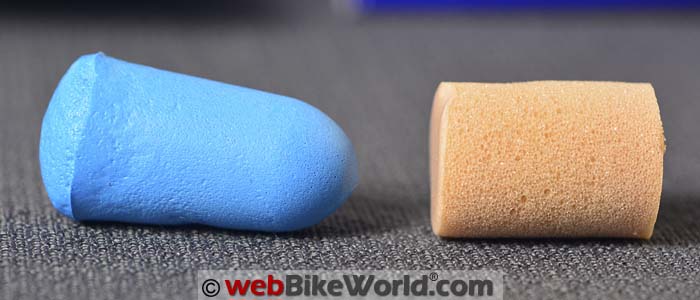
Why Disposable Ear Plugs?
Over the years, we’ve reviewed a bunch of ear plugs on webBikeWorld.
That includes everything from cheap disposables to the ultra-high-end Bose QuietComfort 20 electronic noise reducing earbuds (review) and we always go back to disposables.
For the money, you can’t beat disposables. Lose one? Who cares. Keep a few extra in your pocket. You can even clean them and re-use them multiple times (see below).
The good ones get up to 32-33 NRR (Noise Reduction Rating), which is about as good as you’ll get with any passive sound reducing ear plugs.
And disposable soft foam ear plugs expand to fit your ear, which is one of the bests things about them compared to other types.
Do It Right!
However, they must be inserted correctly, something that does take practice.
As they expand deep in your ear canal, you’ll feel the world evaporating around you as the noise fades away, going from a roar to a whisper.
Correct insertion means the earplug isn’t hanging out of your ear.
Roll it up tight, insert deep inside while you pull your ear back using the opposite hand.
If you don’t push it in far enough, you can actually get more noise than if you didn’t have an ear plug there at all, because the incorrectly inserted plug opens your ear canal and focuses sound, like if you put your hand next to your ear.
You may have to hold the end with a fingertip to keep them pushed in as they expand, but once they do (and if you’ve done it right), it’s magic.
And don’t worry about completely blocking out all of the noise and not hearing anything.
That’s impossible, for two reasons.
First, no passive ear plug of any type can completely block all of the noise. And even with 32-33 NRR ear plugs, riding a motorcycle can still sound pretty noisy.
Also, you get a lot of noise transmission through bone and other parts of your face and skull. You could seal your ears with concrete and you’ll still be able to hear.
So anyone who tells you that “they can’t hear anything” when wearing ear plugs is either being overly dramatic or outright wrong.
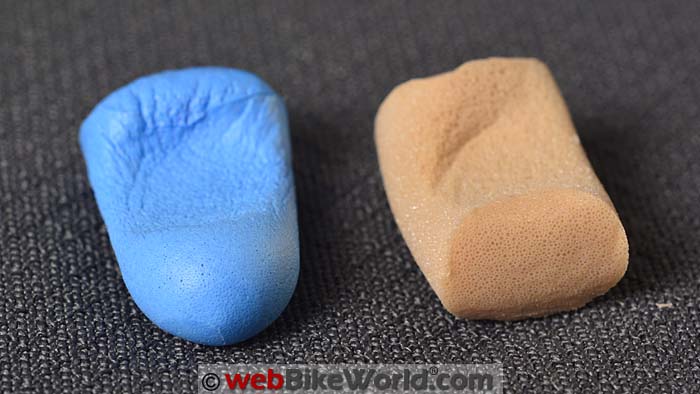
Remember E-A-R Soft Grippers?
My most recent favorite ear plugs are the discontinued uncorded E-A-R Earsoft Grippers.
They’re monsters — at 15 mm wide, 28 mm long and tapering to about 11 mm at the small end, they’re huge and the foam is dense (but comfortable) and they even have big ridges to hold tight.
For me, nothing beats them but note that I have a special problem: I have really big ear canals with one side noticeably larger than the other.
The Grippers are about the only disposable ear plugs that fit tight; I have to insert others backwards, big end first, to work and some are too small even then.
So the Grippers are the best foam disposables for me and there’s no question that they block more noise than anything else I’ve tried, although admittedly they’re probably too big for most people (which may be why they were discontinued).
By the way, 3M has bought up many old-line ear plugs manufacturers over the years, like Peltor and E-A-R.
And they still make the Grippers in a corded version, but you’d have to cut the cord to wear them under a helmet.
Since the uncorded Grippers are no longer available, we’ve been searching for an alternative and came across the latest version of the Hearos Xtreme, so let’s take a look.
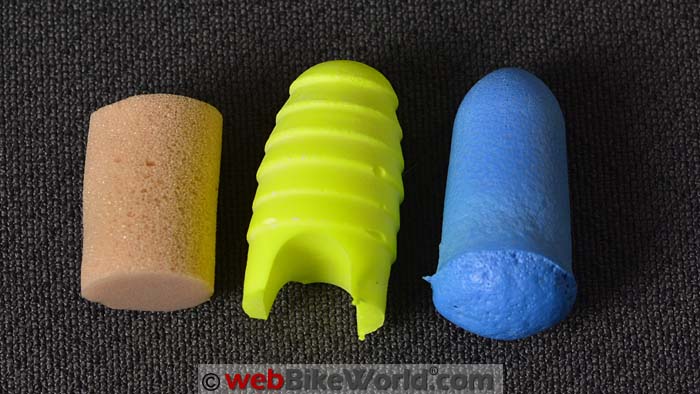
 Hearos Xtreme Protection
Hearos Xtreme Protection
We actually an older version of these called Extreme Hearos (review) “Ear Filters” way back in 2004 but they’ve been revised and they’re now called “Hearos Xtreme”.
The molding is different on this newest version; it has a visible mold line around the top, or widest end.
It looks like the gang mold is placed horizontally when the liquid foam is poured, which then bubbles up and forms a dome on top.
Otherwise, as near as I can tell, the old and new versions are similar. The color is the same and I’d have to assume the foam formula is also.
My approximate measurements put these at 30 mm long and about 14 mm wide at the big end, tapering down to around 11 mm before the point at the narrow end.
The foam that Hearos uses in the Xtreme ear plugs is very soft — press down on one and it feels about like a fresh marshmallow (see photo).
They’re definitely softer than the dense foam used in the Grippers and much softer than the Mack’s ThermaFit.
The Hearos Xtreme foam is easily compressed, with a “controlled” expansion into the ear canal.
These are fairly big ear plugs, but they’re so soft and gentle that they should work for just about anyone.
In fact, these are probably the softest and squishiest disposable foam ear plugs you’ll find anywhere and you’d have to have very sensitive ears to feel any pressure as they expand.
And most importantly, they block a lot of noise.
Which by the way, brings me to another point: it may take a few tries to become accustomed to wearing disposable foam expanding ear plugs if you haven’t before.
Don’t stick one in and go yelling to Momma right away if they feel weird. At least give ’em a few rides and a few tries first.
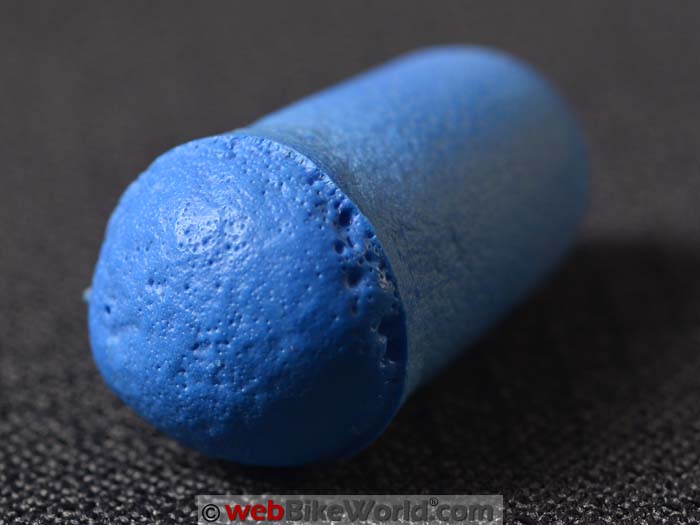
A Few Hearos Details
Hearos ear plugs are made in the U.S.A. and these have a 33 NRR, which is about as high as that number gets for disposable ear plugs.
I have also tried what used to be called “Super Hearos” (a good name, when you think about it), but they’re apparently no longer made.
There’s now something called “Hearos Ultimate Softness” that look to be the same. They go for around $4.75 for a pack of 20 and they do live up to their name as being soft.
They have a 32 NRR but for some reason they don’t seem to block as much noise as that NRR rating implies, which is a problem I’ve noticed with several ear plugs, including the Mack’s ThermaFit.
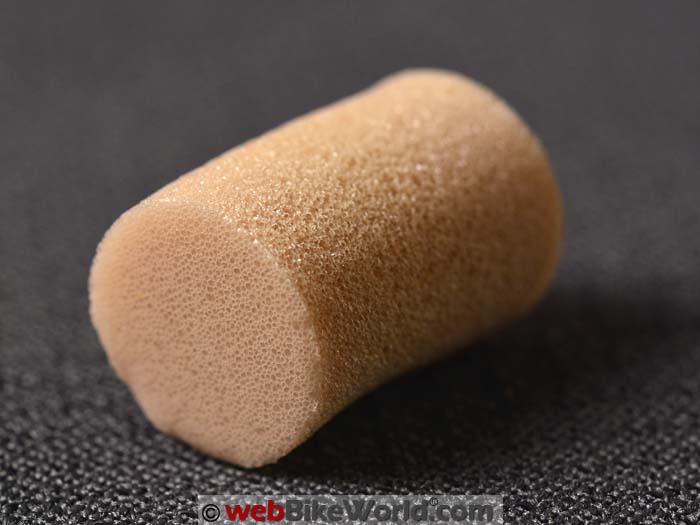
Mack’s ThermaFit
We reviewed the Mack’s silicone ear plugs in 2006 and didn’t like them, for several reasons. First, they’re not disposable, so they get dirty.
[UPDATE: Mack’s instructions state “Discard when soiled or no longer sticky (up to 5 uses).”]Also, they don’t expand into the ear canal. In fact, they’re designed specifically not to go into the ear canal. They only flatten against the outside of the ear canal.
The combination of those two facts is why they only have a 22 NRR rating, which is not enough to be considered for motorcycle riding.
The Mack’s ThermaFit are not silicone however; they’re the foam type and the retail packaging is found in local pharmacies and supermarkets, usually at the checkout line.
They have the classic “old school” ear plug shape: a relatively short cylinder, with no taper.
The foam is more “foamy” looking, with zillions of tiny bubble holes (as you can see in our close-up photo) but these are definitely a lot stiffer than the Hearos Xtreme.
[UPDATE: They are made with PVC, which is a bit firmer than most other earplug styles. Mack’s said this is by design as the ear plug stiffness helps assist with insertion and the foam softens up with body heat quickly after insertion for comfortable wear.]The Mack’s ThermaFit ear plugs measure 14 mm in diameter and they’re just 20 mm long; fully 33% shorter than the Hearos and this makes them more difficult to get correctly inserted in the ear and especially difficult to remove after a ride.
If you have thick fingers, forget these; you probably won’t be able to pick them out of your ear. I have thin fingers and I have a hard time digging them out.
Mack’s calls these “ThermaFit” but I’m not sure if that’s just a marketing term or not, because I notice no change at all with temperature differences.
The claim is that they use “body heat to conform to the unique contours of your ears”. Really? Every foam disposable conforms to the shape of your ear canal and the Hearos do it way better.
Not that the Mack’s ear plugs don’t function to block some noise; they’re not bad actually, once you get them in.
And if you have a smaller or shorter ear canal, maybe these are for you.
But if you’ve been sensitive to disposable foam ear plugs in the past, I’d recommend not even trying these. The stiffer foam feels kind of scratchy.
They’re also rated at 29 NRR, which turns out to be a significant difference from the 32 NRR of the Hearos that is noticeable when riding a motorcycle.
They work, but there’s a noticeable difference with significantly less noise reduction in my subjective experience.
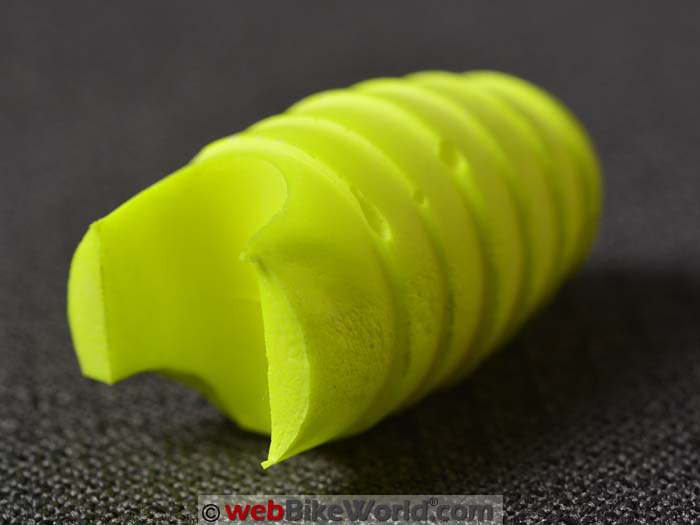
Noise Reduction Rating Explained
By the way, here’s another “by the way”. The NRR number doesn’t mean the ear plugs reduce the noise by the actual listed number.
So for example, a 33 NRR doesn’t mean you get 33 dB of noise reduction. To figure out how much you’ll get, just use this simple formula:

Or for non-brainiacs, here’s the rough translation, per the .pdf above: just take the NRR number, subtract 7 and divide by 2 to get the actual reduction.
Example: for the Mack’s ThermaFit at 29 dB NRR, that yields 29−7=22 and 22÷2=11.0 for an 11.0 dB actual average noise reduction.
[UPDATE: Why divide by 2? Apparently, it’s a 50% safety factor, according to OSHA (.pdf).More on the calculation here (Cooper Safety) and here (3M, .pdf). The point is that the manufacturers are being rather sneaky when they list an NRR of, say, 32 NRR when you don’t actually get the full 32 NRR.]
It is said that riding a motorcycle can generate noise levels around 100 dB or more, so a reduction by 11.0 is about as good as you’ll get from this particular ear plug and that means there’s still a significant amount of noise.
Try Different Shapes and Sizes
Which brings me to an important sidebar point: have you noticed that disposable ear plugs come in a wide variety of shapes, foam types and even sizes?
You’ll probably have to try several different brands to find one that fits, that is comfortable and that blocks enough noise. Usually, if you get #1 and #2, the result is #3 (but not always).
One More Tip
This was actually sent by a webBikeWorld visitor a long time ago. You can wash and clean foam ear plugs by simply placing them in a small dish or container of water with some dishwashing liquid.
Squeeze the soapy water into them and let them sit overnight and the next morning they’ll be nice and clean.
Rinse carefully under the faucet and squeeze out as much water as you can, then let them air dry.
It takes a couple of days for the entire process but you can do this multiple times.
You’ll save some money, although I’m not sure of the environmental equivalence of disposing the ear plugs vs. using soap and water to clean them.
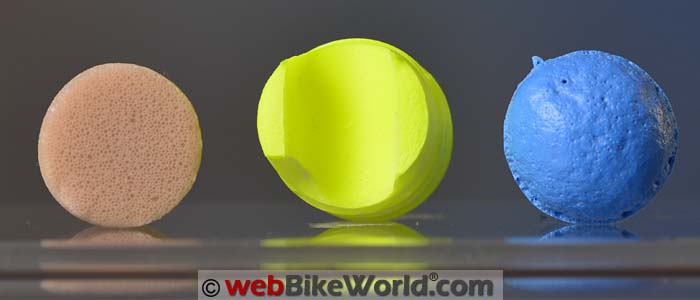
Pricing
Back in 2004, the Extreme Hearos (as they were called back then) came in a pack of 7 pair (14 total ear plugs) for $5.49 list ($0.39 each) and we thought that was too expensive.
They’re now sold in a 14 pair pack (28 total) with a list price of $9.95 — obviously one of those fake list prices that never happens, because you can find this pack retailing for around $7.00, or $0.25 each, which is still a bit rich.
The reason for the high price? This is the retail packaging you’ll find in the local pharmacy or supermarket.
You’re better off buying a bulk pack of 100 pair (200 ear plugs) for $24.99, which is a much better deal at $0.125 each (twelve and a half cents), about the going rate for good quality disposables.
For comparison, a 200-pack of the Moldex PuraFit 6800 ear plugs (a long-ago favorite) goes for around $24.00, or $0.12 each.
The Mack’s ThermaFit ear plugs come in a pack of 10 pair (20 ear plugs), with a list price of $7.49, or a very expensive $0.375 each.
I haven’t found any bulk packs of Mack’s, so the price of these and their weak performance and comfort put them out of the running in my opinion.
Conclusion
My overall favorite ear plugs are the uncorded E-A-R Soft Grippers, but they’re unfortunately no longer available.
They fit my big ear canals and they really seal out the noise. They’re also easy to remove.
But in second place comes the Hearos Xtreme. They’re very soft and yet they’re big enough for me, but they’re so squishy that they work for smaller ear canals also.
More wBW Noise Cancelling Earbud Reviews
Owner Comments and Feedback
See details on submitting comments.
From “C.E.” (February 2017): “The E.A.R. Soft Grippers have been my favorite for years. True, you can’t buy them cordless any more. I just cut the cords off, takes two seconds, and they work as advertised.
However, I have been testing the Howard Leight Laser Lite Multi-Color foam earplugs out for the past few months. I like them even more for my ears.
They last longer, fit me better, and let in the right sounds from my bike and helmet speakers (uClear Force HD speakers).
These also are corded and I just snip them off. Thanks for the great reviews over the years.”
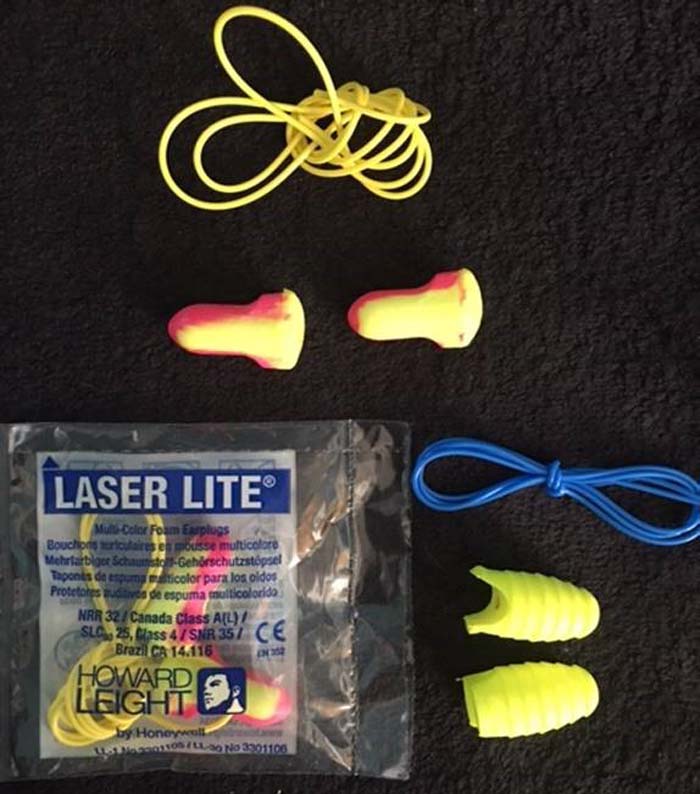
From “B.P.” (February 2017): “In the early years, I tried assorted disposable ear plugs, and never bonded with any brand. At one Americade rally, I decided to try out a pair of custom-molded plugs.
This is the kind for which you get some bubble-gum-like material squeezed into your ear, and you sit still for 15 or 20 minutes.
The mixture hardens, the whole thing is taken out, and some material is trimmed off and some edge-smoothing is also usually performed.
In my experience, I think they work great. I find the noise reduction admirable, and that they’re quick and easy to insert and remove.
The trick in doing that, by the way, is to twist them about a half revolution — a mirror image on each side — when putting them in or, less importantly, when taking them out.
These were $50 or maybe $60, and lasted for three or four years before cracks developed, at least in my use. And so I got a second set, at another Americade.
And after yet some more years, I decided to let my audiology professionals have a go. I wear in-the-ear hearing aids (and you want to talk expensive, you should see the price of those babies).
They’re plastic, and the local folks put the same sort of bubble gum in my ears, but in this case that material is shipped to some factory; about a week later, the plastic-shelled electronic gizmos arrive.
I learned that they do the same thing for ear plugs. That is, ship out the hardened mold. What came back is a solid silicone (or something very much like that) custom-molded ear plug. And that’s now my favorite way of doing things.
The new plugs are extremely smooth, a little pliable, and there’s nary an unrounded edge to them. Yep, they were expensive enough — $80 per ear — that, as you state, “if you lose one you’ll cry.”
So far, no crying (in the decade or so of those three sets, including two years with the silicone version), and if I did lose one I’d go this route again. Oh, and they came with a pop-in cord, to fasten the two together, but I discarded that.
The bottom line is that I prefer not to fiddle around after each stop, with squeezing, pushing, and possibly waiting to see whether I did everything right with a disposable plug.
And now I suppose you’re going to start discussing decibels and suchlike. I can’t help you, or me, on that front. I have no idea.
Regarding the custom plugs from vendors, these are the same folks — I’ve chatted with them — who make these same products for sale at gun shows.
I would think that word would get around if they don’t do the job on the range, which is certainly a loud environment (and I blame at least some of my hearing loss on my days in the Army, almost 50 years ago, when I’m pretty sure we weren’t issued any hearing protection at all on rifle ranges).
And regarding my latest version, the folks at the hearing aid office are aware that these were for motorcycle riding. So I view that as another sort of endorsement.
Next visit, I’ll try to remember to ask them if they have any dB-reduction numbers for them.
When I’m going for a ride to the hardware store, I’ll just leave my in-the-ear hearing aids in place, but turn them off. That’s one form of noise reduction, but, yes, it’s not acceptable for anything but a quick and slow-speed trip.
Anything longer than that, I swap the hearing aids for the silicone plugs, and I’m good to go, for anything from a track day to a 600-mile superslab yawner. That’s my story.
Here’s a pic of two sets of rally-on-site-produced plugs (and, yeah, I could’ve done a better job of keeping them clean), my current set of factory-produced silicone plugs, and current hearing aids.
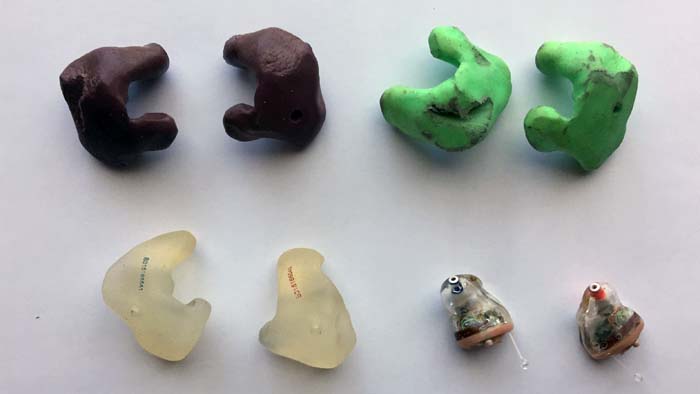


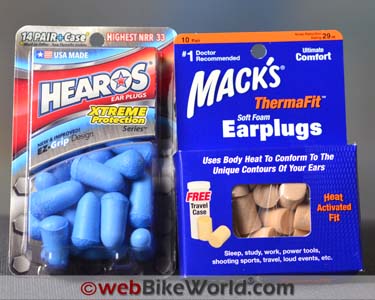
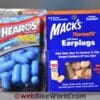
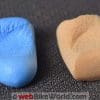
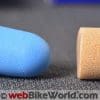
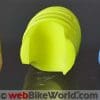
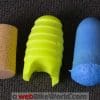
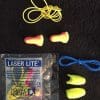
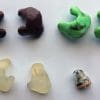
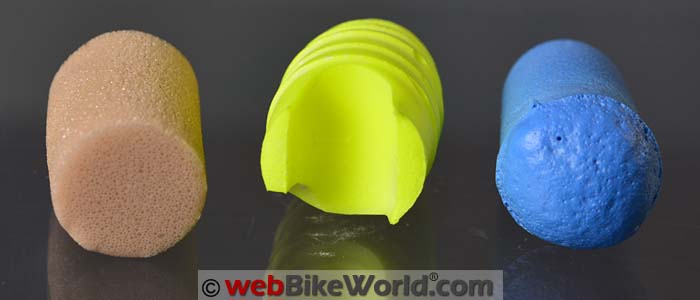 Hearos Xtreme Protection
Hearos Xtreme Protection